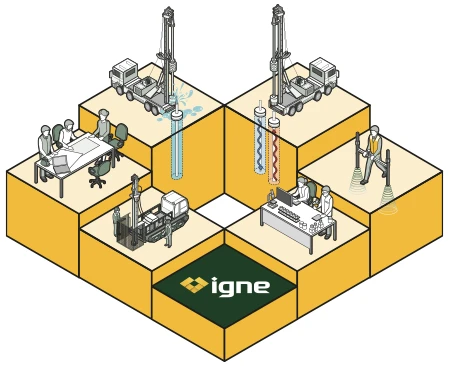

Track Monitoring
Track monitoring refers to the continuous or periodic measurement of the movement, deformation, or alignment of railway tracks, roadways, or other transport networks.
About
What Specifically is Track Monitoring?
Track monitoring is a critical component of modern infrastructure and construction projects, especially when railways, roads, or other key transport networks are involved. Monitoring the stability and condition of tracks during construction or operational use is essential to ensure the safety, efficiency, and long-term integrity of these networks.
Igne’s track monitoring services offer real-time data and expert analysis, enabling project managers to maintain control over their infrastructure projects and respond proactively to any changes or risks.
Track monitoring involves the use of sensors and advanced monitoring technology to track changes in the structure of the track or the surrounding ground.
By collecting accurate, real-time data, track monitoring helps ensure that the tracks remain stable and safe for use, especially during or after construction activities nearby.
This type of monitoring is essential for identifying potential issues that could compromise the integrity of the tracks, such as ground movement, subsidence, or structural shifts. It also helps ensure that transportation networks meet safety regulations and performance standards.

Useage
Why Carry Out Track Monitoring?
Carrying out track monitoring can be crucial for reasons including:
Safety
Track monitoring ensures that any movements or deformations in the track are detected early, allowing corrective action to be taken before safety is compromised. This is particularly important for rail networks, where even minor changes in track alignment can have serious safety implications.
Minimising Disruptions
Continuous monitoring allows project teams to manage risks more effectively, helping to minimise disruptions to rail or road services. By addressing issues early, teams can avoid costly delays or shutdowns.
Regulatory Compliance
Many infrastructure projects are subject to strict safety and performance regulations. Track monitoring ensures that the track remains compliant with these regulations, providing the necessary documentation to satisfy regulatory bodies.
Protection of Assets
By monitoring the condition of tracks, project teams can ensure that the surrounding infrastructure, such as bridges or tunnels, is not affected by changes in track alignment or ground conditions. This helps protect valuable assets and prolong the lifespan of the infrastructure.
Trust
Why Trust Us for Your Track Monitoring Survey Needs?
When it comes to track monitoring, we are a trusted partner, offering expert services that provide accurate and reliable data. Here’s why you should trust us for your track monitoring needs:
Experienced Team
We have a team of skilled engineers and surveyors with extensive experience in track monitoring and infrastructure projects. We understand the complexities involved in monitoring transport networks and the critical importance of delivering accurate data.
Advanced Tech
We use state-of-the-art monitoring equipment and systems to ensure that track movements and deformations are detected with the highest level of precision. Our real-time monitoring solutions allow for immediate detection and analysis of any changes in the track or surrounding environment.
Tailored Solution
We know recognises that every project is unique, which is why we tailor our track monitoring services to meet the specific needs of your site. Whether you're monitoring a railway, a road network, or another critical transport asset, we provide customised solutions designed to address the unique risks and requirements of your project.
Comprehensive Reporting
Our track monitoring services include detailed reporting and real-time alerts, ensuring that project teams have access to the data they need to make informed decisions. We provide actionable insights, not just raw data, to help you manage your project effectively.
Risks
The Risks of Not Doing Track Monitoring
Failing to implement track monitoring on a construction or infrastructure project can lead to significant risks, including but not limited to:
Safety Hazards
Without proper monitoring, track movements or deformations could go unnoticed, potentially leading to accidents or derailments. This is especially critical in rail infrastructure, where minor misalignments can have severe consequences.
Costly Delays
If track instability or ground movement is not detected early, it could cause major disruptions to rail or road services, resulting in costly delays and repairs. Unmonitored tracks could also require unexpected maintenance, further increasing project costs.
Non-compliance with Regulations
Many infrastructure projects must comply with strict safety and performance regulations. Failing to carry out track monitoring could result in non-compliance with these regulations, leading to fines, project delays, or even legal action.
Damage to Adjacent Structures
Without track monitoring, structural movements caused by nearby construction could impact surrounding infrastructure, such as bridges, tunnels, or retaining walls. This could lead to significant damage and expensive repairs.
Benefits
How Track Monitoring Can Help
Implementing a track monitoring programme offers a range of benefits such as:
Enhanced Safety
Continuous monitoring ensures that track movements and deformations are detected early, allowing for timely corrective actions that maintain the safety of railways and roadways.
Cost Savings
By identifying issues early, track monitoring helps prevent expensive repairs, service disruptions, and unplanned maintenance. This proactive approach can save significant costs over the course of the project.
Real-time Data & Alerts
Tack monitoring systems provide real-time data and alerts, allowing project teams to respond quickly to any changes. This ensures that potential problems are addressed before they escalate.
Improved Asset Protection
Track monitoring helps protect valuable infrastructure assets by identifying ground movements or structural shifts that could compromise the integrity of the surrounding environment.
Regulatory Compliance
Track monitoring ensures that your project complies with all relevant safety and performance regulations, providing the necessary documentation to demonstrate compliance to regulators.
Process
How is Track Monitoring Done?
Our track monitoring services utilise advanced monitoring systems to provide accurate, real-time data on track conditions. Here, broadly, is how the process works:
- Initial Assessment
We start by conducting an initial assessment of the site to identify the key areas that require monitoring. This may include evaluating ground conditions, track alignment, and potential risks posed by nearby construction activities. - System Design
Based on the assessment, we design a customised track monitoring system that uses a combination of sensors, inclinometers, and other monitoring tools to track movements in the track or surrounding ground. - Installation
Our team installs the necessary sensors and monitoring equipment on-site. These devices are strategically placed to ensure comprehensive coverage of the track and any adjacent infrastructure that may be affected by changes in ground conditions. - Data Collection & Reporting
Once the system is operational, data is collected continuously and transmitted in real-time to our cloud-based monitoring platform. We provide regular reports and real-time alerts to project teams, allowing them to monitor track conditions and respond to any changes immediately. - Ongoing Support
Throughout the duration of the project, we provide ongoing support to ensure that the track monitoring system continues to function effectively. We also adjust the system as needed to address any changes in project conditions or requirements.
Learn More
Frequently Asked Questions about Remote Monitoring Surveys
- What is track monitoring in construction?
It involves the continuous or periodic measurement of track conditions to ensure stability and safety. This can include monitoring track alignment, ground movements, or environmental changes that may impact the track.
- Why is track monitoring important?
It is crucial for ensuring the safety of railway and road networks. It helps detect early signs of movement or deformation, allowing project teams to take corrective actions before problems escalate.
- How is track monitoring done?
As described above, track monitoring is typically done using sensors and monitoring equipment placed along the track and in the surrounding environment. These devices collect real-time data on track conditions, which is transmitted to a monitoring platform for analysis.
- What types of projects require track monitoring?
It is essential for infrastructure projects involving railways, roads, or other critical transport networks. It is particularly important for projects where construction activities may impact the stability of the track.
- What are the benefits of track monitoring?
Benefits of track monitoring include improved safety, reduced costs, real-time data and alerts, enhanced asset protection, and regulatory compliance.
The Next Step
Our track monitoring services provide the real-time data and expert analysis you need to ensure the safety and stability of your transport networks.
Whether you’re managing a railway, road, or other critical infrastructure, our team is here to help you stay in control of your project.
Contact us today to learn more about our track monitoring services and explore the full range of monitoring surveys we offer to de-risk and optimise your project.
